14. Water-Soluble Contrast Media
Authors: Dahnert, Wolfgang
Title: Radiology Review Manual, 6th Edition
Copyright 2007 Lippincott Williams & Wilkins
> Table of Contents > Water-Soluble Contrast Media
Water-Soluble Contrast Media
Ionic = dissociation in water
Nonionic = soluble in water (hydrophilic); no dissociation in solution
Iodine-to-particle ratio:
= quotient of iodine atoms (attenuation of rays) and number of particles (osmotoxic effect)
ratio 1.5 agents = high-osmolar contrast media (HOCM)
ratio 3.0 agents = low-osmolar contrast media (LOCM)
ratio 6.0 agents = isotonic contrast media (IOCM)
Ionic Monomers
= monoacidic salts composed of benzoic acid derivatives, with 3 hydrogen atoms replaced by iodine atoms + 3 hydrogen atoms replaced by simple amide chains
in solution: strong organic acid completely dissociated (ionized) into negatively charged ions / anions
Conjugated cations:
sodium
methylglucamine (meglumine)
combination of above
Iodine concentration: up to 400 mg/mL
Iodine-to-particle ratio: 3:2 or 1.5:1
Osmolality: 1,400-2,100 mOsm/kg = HOCM
Ionic Dimers
Construction:
2 iodinated benzene rings containing 6 iodine atoms, one of which contains an ionizing carboxyl group; benzene rings are connected by a common amide side chain
 |
Acetrizoate |
The parent triiodinated contrast medium in first clinical use; the benzene ring is attached to a carboxyl (COO-) group at the 1-carbon position and conjugated with sodium / meglumine
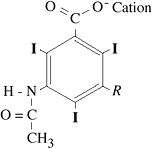 |
Diatrizoate |
The unsubstituted hydrogen of acetrizoate has been exchanged for another acetamido unit leading to higher biologic tolerance through higher degree of protein binding Iodine concentration: up to 350 mg/mL Iodine-to-particle ratio: 3:1 Compounds: iohexol, iopamidol, ioversol, iopental,
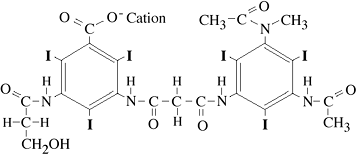 |
Ioxaglate (Hexabrix ) |
Sodium + meglumine are conjugated with the carboxyl group
Conjugation with: sodium + meglumine
Compound: ioxaglate (the only available)
Iodine concentration: 320 mg/mL
Iodine-to-particle ratio: 6:2 or 3:1
Osmolality: 600 mOsm/kg = LOCM
Nonionic Monomers
Construction:
benzoic acid carboxyl group replaced by amide; side chains have been modi.ed by adding 4-6 hydroxyl (OH) groups, which allows solubility in water
 |
Metrizamide |
The first compound with 4 hydroxyl groups positioned at one end of the molecule on the glucosamide moiety
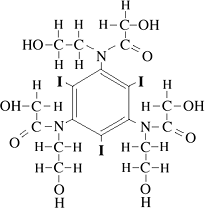 |
Iohexol (Omnipaque ) |
contains 6 hydroxyl (OH) groups more evenly distributed around the molecule improving subarachnoid toxicity
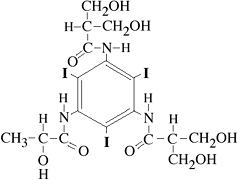 |
Iopamidol (Isovue ) |
This nonionic monomer contains 5 hydroxyl (OH) groups
 |
Ioversol (Optiray ) |
This nonionic monomer contains 6 hydroxyl (OH) groups
P.1131
Iodine concentration: up to 350 mg/mL
Iodine-to-particle ratio: 3:1
Compounds: iohexol, iopamidol, ioversol, iopental, iopromide (Ultravist ), iobitridol (Xenetix ), ioxilan (Oxilan )
Osmolality: 616-796 mOsm/kg
Nonionic Dimers
Construction:
contain up to 12 hydroxyl groups to eliminate ionicity, increase hydrophilicity, lower osmotoxicity, and increase iodine atoms per molecule
Iodecol, iotrolan (Isovist ), iodixanol (Visipaque )
Iodine-to-particle ratio: 6:1
Osmolality: hypo- / isoosmolar
Excretory Urography
Clearance:>99% of contrast material eliminated through kidney (<1% through liver, bile, small and large intestines, sweat, tears, saliva); vicarious excretion with renal insult / failure (may be unilateral as in obstructive uropathy)
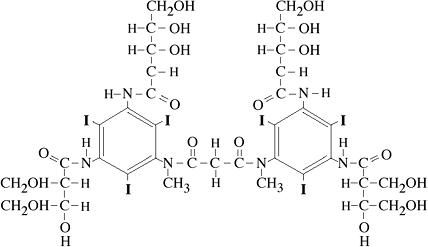 |
Iotrolan (Iotrol ) |
This noniomic dimer contains 12 hydroxyl (OH) groups
Physicochemical Properties of Commonly Used Radiographic Contrast Media
| Contrast Media | Compound | mOsm/kg H2O | Viscosity (cps) at 37 | Iodine mg/mL | |
|---|---|---|---|---|---|
| Ionic monomers | |||||
| Uroradiological | |||||
| Cysto-Conray II (Mallinckrodt) | Meglumine-iothalamate | 1,300 | 4 | 202 | |
| gastrointestinal | |||||
| Hypaque Sodium Oral Solution (Nycomed Amersham) | Na diatrizoate | 1,300 | 4 | 249 | |
| Gastrografin (Bracco) | Na-meglumine diatrizoate | 1,940 | 8.4 | 370 | |
| Intravascular | |||||
| Renovue -DIP (Bracco) | Meglumine | iodamide | 433 | 1.8 | 111 |
| Conray-60 (Mallinckrodt) | Meglumine iothalamate | 1,400 | 4 | 282 | |
| Renografin -60 (Bracco) | Na-meglumine diatrizoate | 1,450 | 4 | 292 | |
| Ionic dimers | |||||
| Hexabrix (Mallinckrodt) | Na-meglumine ioxaglate | 600 | 7.5 | 320 | |
| nonionic monomers | |||||
| Oxilan 300 (Cook) | ioxilan | 585 | 5.1 | 300 | |
| Ultravist 300 (Berlex) | iopromide | 607 | 4.9 | 300 | |
| Isovue 300 (Bracco) | iopamidol | 616 | 4.7 | 300 | |
| Optiray 300 (Mallinckrodt) | ioversol | 651 | 5.5 | 300 | |
| Omnipaque 300 (Nycomed Amersham) | iohexol | 672 | 6.3 | 300 | |
| Omnipaque 140 (Nycomed Amersham) | iohexol | 322 | 1.5 | 140 | |
| Omnipaque 240 (Nycomed Amersham) | iohexol | 520 | 3.4 | 240 | |
| Omnipaque 350 (Nycomed Amersham) | iohexol | 844 | 10.4 | 350 | |
| Nonionic dimers | |||||
| Iotrol 300 (Schering AG) | iotrolan | ~310 | 9.1 | 300 | |
| Visipaque -320 (Nycomed Amersham) | iodixanol | 290 | 11.8 | 320 | |
| Osmolality of human serum is 290 mOsm/kg! | |||||
| The higher the number of hydroxyl groups, the larger the size + the higher the viscosity + the higher the hydrophilicity! This decreases protein- and tissue-binding properties making the compound biologically more ! | |||||
P.1132
Halftime: 1-2 hours (doubled in dialysis patients)
Concentration: 60% by weight
Sodium-containing HOCM
 less distension of collecting system
less distension of collecting system
Meglumine-only HOCM
 improved distension of collecting system (due to decreased tubular resorption of water)
improved distension of collecting system (due to decreased tubular resorption of water)
LOCM
 denser nephrogram + slightly denser pyelogram than HOCM (due to higher tubular concentration)
denser nephrogram + slightly denser pyelogram than HOCM (due to higher tubular concentration)
Angiography
Burning sensation:
intense with concentration of 60-76% HOCM
reduced with concentration of 30% HOCM / LOCM
 Overall incidence of adverse allergic-type reactions is (for unknown reasons) much less with intra-arterial than with intravenous use of contrast media!
Overall incidence of adverse allergic-type reactions is (for unknown reasons) much less with intra-arterial than with intravenous use of contrast media!
Venography
Foot / calf discomfort or pressure or burning
~24% with 60% HOCM
~5% with 40% HOCM / 300 mg iodine/mL LOCM
 The addition of 10-40 mg lidocaine/50 mL of contrast media decreases patient discomfort!
The addition of 10-40 mg lidocaine/50 mL of contrast media decreases patient discomfort!
Postphlebography deep vein thrombosis
26-48% with 60% HOCM
0-9% with dilute HOCM / LOCM
 Infusion of 150-200 mL of 5% dextrose in water / 5% dextrose in 0.45% saline / heparinized saline through injection site immediately after examination reduces likelihood of DVT!
Infusion of 150-200 mL of 5% dextrose in water / 5% dextrose in 0.45% saline / heparinized saline through injection site immediately after examination reduces likelihood of DVT!
Contrast Material in Pediatrics
Conventional dose: 1 mL / pound up to 150 mL
Maximum dose: 280-300 mg I/mL
Adverse Contrast Reactions
Nonidiosyncratic (= dose-related) reactions
Cause: direct chemotoxic / hyperosmolar effect
nausea, vomiting
cardiac arrhythmia
renal failure
pulmonary edema
cardiovascular collapse
Idiosyncratic (= anaphylactoid) reactions
= reactions occurring unpredictably + independently of dose / concentration = not a true antigen-IgE antibody-mediated reaction nor a reaction to iodine / iodide
Cause: unknown
hives, itching
facial / laryngeal edema
bronchospasm, respiratory collapse
circulatory collapse
Delayed reactions
erythematous rashes, pruritus
fever, chills, ulike symptoms
joint pain
loss of appetite, taste disturbance
headache, fatigue, depression
Prevalence of Adverse Contrast reactions
High-osmolar Ionic Low-osmolar Nonionic Non-life-threatening reaction 1-2% 0.2-0.4% Life-threatening reaction 0.2% 0.04% Mortality 1:100,000 1:100,000 Late reaction 6% abdominal pain, constipation, diarrhea
Signi.cant underlying medical conditions:
renal disease
cardiac disease
blood dyscrasias
pheochromocytoma
increased symptoms with COPD plus pulmonary hypertension
increased sickling in patients with sickle-cell disease
 Approximately 20-40% of population are at increased risk for adverse reaction to contrast media!
Approximately 20-40% of population are at increased risk for adverse reaction to contrast media! In patients with adverse reactions to HOCM repeated reactions will be lowered to 5% by using LOCM
In patients with adverse reactions to HOCM repeated reactions will be lowered to 5% by using LOCM No direct correlation / association to povidone-iodine skin cleansing solution (Betadine )
No direct correlation / association to povidone-iodine skin cleansing solution (Betadine )
Nephrotoxicity
Nonoliguric Transient Renal Dysfunction
= transient decline of renal function
serum creatinine level peaks on days 3-5
serum creatinine returns to baseline values within 14-21 days
fractional excretion of sodium < 0.01 (DISTINCTIVE CHARACTERISTIC compared with other causes)
Acute Renal Failure
= sudden + rapid deterioration of renal function
= increase in serum creatinine of > 25% or to > 2 mg/dL within 2 days of receiving contrast material
Risk Factors and Incidence of Adverse reactions for High- and Low-Osmolality Contrast Media
| Type of Reaction | HOCM | LOCM [%] |
|---|---|---|
| Overall incidence | ||
| Australia (Palmer et al.) | 3.80 | 1.20 |
| United States (Wolf et al.) | 4.20 | 0.70 |
| Japan (Katayama et al.) | 12.70 | 3.10 |
| Severe adverse reactions | 0.22 | 0.04 |
| Severe allergies to drugs, foods, etc. | 23.40 | 6.90 |
| Asthma | 19.70 | 7.80 |
| Repeat reaction to contrast media | 16-44 | 4.1-11.2 |
P.1133
Frequency:1-30%; 3rd most common cause of in-hospital renal failure after hypotension and surgery
Risk factors:
Preexisting renal insuf.ciency (serum creatinine <1.5 mg/dL)
Diabetes mellitus with renal insuf. ciency (possibly related to dehydration / hyperuricemia)
 Ratio 3 nonionic LOCM appear to be 50% less nephrotoxic than ratio 1.5 ionic HOCM
Ratio 3 nonionic LOCM appear to be 50% less nephrotoxic than ratio 1.5 ionic HOCM Diabetics with normal renal function are not at increased risk!
Diabetics with normal renal function are not at increased risk!
Dehydration
Cardiovascular disease
Use of diuretics
Advanced age <70 years
Multiple myeloma (in dehydrated patients)
Hypertension
Hyperuricemia / uricosuria
High dose of contrast material
CAVE:
 Small decreases in renal function may greatly exacerbate the mortality caused by the underlying condition!
Small decreases in renal function may greatly exacerbate the mortality caused by the underlying condition! Metformin (Glucophage ) should be discontinued for 48 hours after contrast medium administration (accumulation of metformin may result in lactic acidosis, which is fatal in 50%)!
Metformin (Glucophage ) should be discontinued for 48 hours after contrast medium administration (accumulation of metformin may result in lactic acidosis, which is fatal in 50%)! It is not necessary to stop metformin after gadolinium administration because gadolinium is not nephrotoxic!
It is not necessary to stop metformin after gadolinium administration because gadolinium is not nephrotoxic!
 Avoid concomitant use of nephrotoxic drugs (eg, gentamycin, NSAIDs)
Avoid concomitant use of nephrotoxic drugs (eg, gentamycin, NSAIDs)
Proposed mechanisms:
contrast agents are concentrated in nephrons + collecting tubules
Vasoconstriction
increase in intrarenal pressure induced by hypertonicity
intrarenal smooth muscle contraction in response to hypertonic substances
RBC aggregation in medullary circulation
Direct tubular cell injury
Potential antidotes:
Hydration (0.9% saline at 100 mL/h) 12 hours before + 12 hours after angiography
 Extracellular volume expansion is the most effective + widely recommended measure!
Extracellular volume expansion is the most effective + widely recommended measure! immediate dense nephrogram persisting for up to 24 hours (in 75%) gradually increasing dense nephrogram resembling bilateral acute ureteral obstruction (in 25%):
immediate dense nephrogram persisting for up to 24 hours (in 75%) gradually increasing dense nephrogram resembling bilateral acute ureteral obstruction (in 25%): bilaterally enlarged smooth kidneys
bilaterally enlarged smooth kidneys poor opaci.cation of urine-conducting structures
poor opaci.cation of urine-conducting structures effacement of collecting system (interstitial edema)
effacement of collecting system (interstitial edema)
Cx: 34% mortality (0.4% of all patients)
Rx: 0.1% require renal replacement therapy
Assessment of Patients before Contrast Injection
General status
Assess hemodynamic, neurologic, general nutritional, anxiety status
History of signi. cant allergies
Prior anaphylactic response to any allergen
Asthma
Renal disease
Renal dysfunction: obtain baseline BUN + creatinine
Diabetes mellitus
Multiple myeloma
 Hydrate patients and limit contrast dose!
Hydrate patients and limit contrast dose!
Cardiac disease
Angina
CHF with minimal exertion
Severe aortic stenosis
Primary pulmonary hypertension
Severe cardiomyopathy
Limit contrast dose!
Treatment of Contrast Reactions
 94-100% of severe + fatal anaphylactoid reactions occur within 20 minutes of contrast medium injection
94-100% of severe + fatal anaphylactoid reactions occur within 20 minutes of contrast medium injection use a plastic cannula for IV access
use a plastic cannula for IV access maintain IV access for 30 minutes
maintain IV access for 30 minutes have emergency drugs close to the room where contrast injections are done
have emergency drugs close to the room where contrast injections are done post a listing of available medications + their common doses in the room
post a listing of available medications + their common doses in the room
Oral Steroid Premedication Protocol
 32 mg methylprednisolone (Medrol ) PO 12 and 2 hours prior to contrast injection
32 mg methylprednisolone (Medrol ) PO 12 and 2 hours prior to contrast injection 50 mg prednisone PO 13 + 7 + 1 hour prior to contrast injection, plus
50 mg prednisone PO 13 + 7 + 1 hour prior to contrast injection, plus50 mg diphenhydramine (Benadryl ) IV / IM / PO 1 hour prior to contrast injection
 nonionic low-osmolality contrast agent
nonionic low-osmolality contrast agentIndication: previous respiratory adverse contrast reaction, history of signi.cant allergies / severe asthma
Caution in patients with: active tuberculosis, diabetes mellitus, peptic ulcer disease
 Antihistamines alone have not proved to be effective!
Antihistamines alone have not proved to be effective!
Treatment of Premedicated Patients
Patient on -blocker
if response to epinephrine inadequate
 1-5 mg glucagon IV + subsequent slow drip of 5 mg glucagon over 60 min
1-5 mg glucagon IV + subsequent slow drip of 5 mg glucagon over 60 min
Patient on calcium channel blocker (eg, nifedipine, nicardipine)
 calcium IV
calcium IV
Excessive vasoconstriction on epinephrine IV
 infusion of 0.5-10 g/kg/min of reconstituted sodium nitroprusside (Nipride ) (50 mg in 500-1000 mL of 5% dextrose wrapped in metal foil during use to protect solution from light)
infusion of 0.5-10 g/kg/min of reconstituted sodium nitroprusside (Nipride ) (50 mg in 500-1000 mL of 5% dextrose wrapped in metal foil during use to protect solution from light)
Metformin (Glucophage )
 Stop metformin medication at time of contrast injection + for subsequent 48 hours
Stop metformin medication at time of contrast injection + for subsequent 48 hours Reinstate medication if renal function remains normal
Reinstate medication if renal function remains normal Contrast material is contraindicated if patient is in renal failure because of risk of lactic acidosis!
Contrast material is contraindicated if patient is in renal failure because of risk of lactic acidosis!
P.1134
Useful Medications
Alpha- and -adrenergic agents:
Action: vasoconstriction, increased cardiac output
 Epinephrine
Epinephrine1 mL glass vials of epinephrine 1:1,000
Adult dose: 0.1-0.2 mL epinephrine (1:1,000) (= 0.1-0.2 mg) SQ
Pediatric dose: 0.01 mL/kg up to 0.3 mL/dose
Repeat in 15-30 minutes if needed
Indications: bronchospasm, facial edema, severe urticaria, laryngospasm
prepackaged 10-mL syringes of epinephrine 1:10,000
Adult dose: 1-3 mL epinephrine (1:10,000) (= 0.1 mg) slowly IV
Pediatric dose: 0.1 mL/kg slowly IV
Repeat every 5-15 minutes if needed
Indications: bronchospasm / laryngospasm with peripheral vascular collapse
Maximum dose: 1.0 mg
 Dopamine (Inotropin )
Dopamine (Inotropin )Adult dose: 2-5 pg/kg/min IV; rarely need to exceed 20 pg/kg/min
Indications: hypotension
Cx: arrhythmia, myocardial ischemia, nausea, vomiting, tremulousness, headache
Atropine sulfate
Adult dose: 0.6-1.0 mg slowly IV
Pediatric dose: 0.02 mg/kg slowly IV (0.2 mg/kg of the 0.1 mg/mL solution); min dose of 0.1 mg (children) + 1.0 mg (adolescents)
Repeat after 5 min
Maximum dose: 0.04 mg/kg (2-3 mg) in adults
Indications: bradycardia, hypotension
Cx: angina, myocardial infarction
Metered-dose inhalers of -adrenergic bronchodilators
 Metaproteranol (Alupent )
Metaproteranol (Alupent ) Terbutaline (Brethaire )
Terbutaline (Brethaire ) Albuterol (Proventil , Ventolin )
Albuterol (Proventil , Ventolin )Dose: 2 puffs every 20-30 minutes, as needed
H1 antagonists = antihistamines
 Diphenhydramine (Benadryl )
Diphenhydramine (Benadryl )Adult dose: 25-50 mg PO/IM/IV
Pediatric dose: 1-2 mg/kg IV, up to 50 mg
 Hydroxyzine (Vistaril )
Hydroxyzine (Vistaril )Dose: 25-50 mg PO/IM/IV
Indications: hives, rash, itching
Cx: hypotension, sedation
H2 receptor blockers
 Cimetidine (Tagamet )
Cimetidine (Tagamet )Dose: 300 mg PO / slowly IV (diluted in 10 mL D5W solution)
 Ranitidine (Zantac )
Ranitidine (Zantac )Dose: 50 mg PO / slowly IV (diluted in 10 mL D5W solution)
Indications: hypotension; bronchospasm
Aminophylline
250 mg in 250 mL of 5% dextrose
Dose: 6 mg/kg IV in D5W over 15-20 minutes (loading dose); then 0.4-1.0 mg/kg/hour
Indications: bronchospasm, pulmonary edema
Cx: hypotension, cardiac arrhythmia
Terbutaline
0.25-0.50 mg IM/SQ
Sedatives
 Midazolam (Versed )
Midazolam (Versed )Dose: 0.5-1.0 mg IV; short acting
Indications: sedation
 Diazepam (Valium )
Diazepam (Valium )Dose: 2-10 mg IV
Indications: seizures
 Pentobarbital (Nembutal )
Pentobarbital (Nembutal )Dose: <50 mg/min IV; 150-200 mg IM
Indications: toxic convulsions
Cx: respiratory depression, apnea, laryngospasm, hypotension
Pain
 Fentanyl
FentanylDose: 25-50 mg IV; short acting
 Morphine
MorphineDose: 1-3 mg IV Indications: pain; pulmonary edema
 Demerol
DemerolCx: respiratory depression
Volume expander
 Crystalloid solution as 0.9% saline
Crystalloid solution as 0.9% saline Hydroxylethyl starch (high-molecular-weight colloid)
Hydroxylethyl starch (high-molecular-weight colloid)
Furosemide (Lasix )
Adult dose: 20-40 mg IV slow push / PO
Pediatric dose: 1 mg/kg/dose IV up to 40 mg
Effect: 5-15 minutes after IV; 60 minutes after PO
Indications: acute pulmonary edema, CHF, hypertensive emergency
Corticosteroids
 Methylprednisolone (Solu-Medrol )
Methylprednisolone (Solu-Medrol )Dose: (a) 32 mg PO; 12 & 2 hours prior
(b) 100-1,000 mg (anaphylaxis with shock)
EAN: 2147483647
Pages: 24